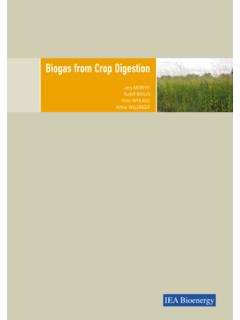Transcription of Biogas upgrading technologies – developments and …
1 Biogas upgrading technologies developments and innovationsAnneli PeterssonArthur WeLLInGerBiogas upgradingIEA BioenergyTask 37 - energy from Biogas and landfill gasIeA Bioenergy aims to accelerate the use of environmental soundand cost-competitive Bioenergy on a sustainable basis, and therebyachieve a substantial contribution to future energy foLLoWInG nAtIons Are CUrrentLY memBers of tAsk 37:Austria rudolf BrAUn, Andrew mcfArLAn, Jens Bo hoLm-nIeLsen, Commission David BAxter, Jukka rIntALA, olivier th oBALD, Peter WeILAnD, Anneli Petersson, switzerland (task leader) Arthur WeLLInGer, netherland mathieu DUmont, Uk Clare LUkehUrst, Anneli Peterssonswedish Gas Centrescheelegatan 3se-212 28 malm , WeLLInGernova energieCh telstrasse 21Ch-8355 Aadorf, switzerland 37 has previously published the following brochures about Biogas upgrading : Biogas upgrading to vehicle fuel standards and grid injection, 2007 Biogas upgrading and utilization, 2000the publications are available on Design: susanne AUerPhotos and Graphs.
2 Anneli Petersson, Arthur WeLLInGeroCtoBer 2009 Biogas upgradingContentContentIntroduction4 Composition of biogas5 Cleaning of biogas6removal of water6removal of hydrogen sulphide7removal of oxygen and nitrogen8removal of ammonia9removal of siloxanes9removal of water9removal of particulates9 Full scale technology for Biogas upgrading9 Pressure swing Adsorption (PsA)9 Absorption10membranes11 Comparison of different upgrading techniques12 New developments in upgrading technology12 Cryogenic upgrading12In situ methane enrichment14ecological lung14 Removal of methane from the off-gas15 List of upgrading plants16 List of Biogas upgrading plant providers18 References19 Abbreviations and definitions190304 Biogas upgradingIntroductionIntroductionBiogas is produced during anae-robic digestion of organic substrates, such as manure, sewage sludge, the organic fractions of household and industry waste, and energy crops.
3 It is produced in large scale digesters found preliminary in industrial countries, as well as in small scale digesters found worldwide. Biogas is also produced during anaerobic degradation in landfills and is then referred to as landfill gas. The worldwide Biogas production is unknown, but the production of Biogas in the European Union was estimated to be around 69 TWh in 2007. The Biogas pro-duction in the European Union has steadily increased over the last years (Fig. 1). Biogas consists mainly of methane and carbon dioxide and it can be utilized as a renewable energy source in combined heat and power plants, as a vehicle fuel, or as a substitute for natural gas.
4 The methane in the Biogas can also be utilized in industrial processes and as a raw material in the and utilization of Biogas has several environmental advantages such as: It is a renewable energy source. It reduces the release of methane to the atmosphere compared to traditional manure management or landfills. It can be used as a substitute for fossil fuels. A high quality digestate that can be used as a fertilizer is produced simultaneously with Biogas . Depending on the end use, different Biogas treat-ment steps are necessary. For some applications, where it is important to have a high energy content in the gas, as vehicle fuel or for grid injection, the gas needs to be upgraded.
5 The energy content of Biogas is in direct proportion to the methane concentration and by remo-ving carbon dioxide in the upgrading process the energy content of the gas is of Biogas has gained increased attention due to rising oil and natural gas prices and increasing targets for renewable fuel quotes in many countries. New plants are continually being built. The number of upgrading plants was around 100 in 2009 (Fig. 2). The process of upgrading Biogas generates new possibilities for its use since it can then replace natural gas, which is used extensively in many countries. Howe-ver, upgrading adds to the costs of Biogas production. It is therefore important to have an optimized upgrading process in terms of low energy consumption and high efficiency giving high methane content in the upgraded gas.
6 It is also very important to minimize, or if possible avoid, emissions of methane from the upgrading pro-cess, since methane has a greenhouse gas effect 23 times greater than that of carbon dioxide. This means that the methane content in the reject gas, in the water from a water scrubber, or in any other stream leaving the upgrading plant should be techniques for Biogas upgrading exist today and they are continually being improved. In parallel, new techniques are under development . These new developments , both for new and more traditional tech-niques, can lower investment costs and operational costs. The developments can also lead to other advan-fig. 1. Biogas production in the european Union between 2002 and 2007 ( Biogas Barometer 2004 2008).
7 Fig. 2. total number of upgrading plants from 1987 to upgradingComposition of biogas05tages such as lower methane emission which is impor-tant from both an economical and environmental per-spective. In this brochure the latest developments in Biogas upgrading are reviewed. This publication is produced by IEA Bioenergy s Task 37: energy from Biogas and landfill gas . More information about the group as well as publications can be found on of biogasDuring anaerobic digestion ( digestion in the absence of oxygen) organic material is broken down in several steps by different types of microorganisms. The end-products are a gas containing mainly methane and carbon dioxide, referred to as Biogas ; and a slurry or solid fraction consisting of what is left of the treated substrate, referred to as digestate.
8 Biogas can be produ-ced from most types of organic raw material, except for lignin, which is not anaerobically degraded. The sub-strate composition will affect the yield of Biogas and its content of methane (Tab. 1). landfill gas is produced during anaerobic digestion of organic materials in landfills and is very similar to Biogas . Its methane content is generally lower than that of Biogas , and landfill gas usually also contains nitrogen from air that seeps into the landfill gas during recovery. landfill gas can also, in contrast to Biogas from farms, contain a great number of trace gases. There are different technologies for the Biogas pro-duction, one stage, two stage and dry digestion. The substrate, the production technology and the collection of the gas, all affect the composition of the gas (Tab.)
9 2).To increase the quality of the raw Biogas , the gas is usually cleaned of unwanted substances such as hydro-gen sulphide, oxygen, nitrogen, water and particulates. The main reason for doing this is to prevent corrosion and mechanical wear of the equipment in which the Biogas is used. The main difference in the composition between Biogas and natural gas relates to the carbon dioxide content. Carbon dioxide is one of the main components of Biogas , while natural gas contains very low amounts. In addition, natural gas also contains higher levels of hydrocarbons other than methane. These differences result in a lower energy content of Biogas per unit volu-me compared to natural gas (Tab.
10 2). By separating carbon dioxide from the Biogas in an upgrading pro-cess, the energy content of upgraded Biogas becomes comparable to natural countries have defined standards for grid injection of upgraded Biogas or for utilization as vehicle *Average during 2007 ( ).Tab. 2. Composition of Biogas , landfill gas and natural gasNatural gas (Danish)*Natural gas (Dutch)methane (vol-%)60 7035 658981other hydro carbons (vol-%) ,5hydrogen (vol-%)00-30 Carbon dioxide (vol-%)30 4015 (vol-%)~ (vol-%)00-500hydrogen sulphide (ppm)0 40000 100 Ammonia (ppm)~100~ 5 0 Lower heating value (kWh/nm3) *Vs = Volatile solidsTab. 1. Biogas yield and methane content of the Biogas from different classes of yield (l/kg VS*) Methane content (%)fat1000 125070 75 Protein600 70068 73 Carbohydrate700 80050 55 Photo 1.









